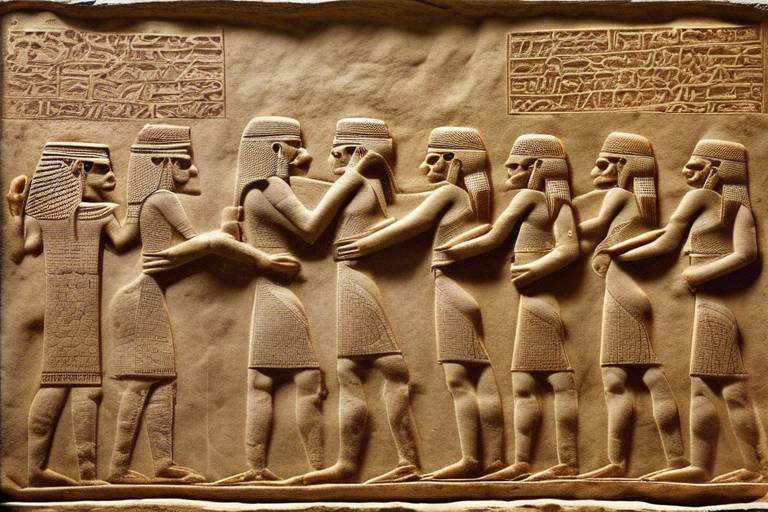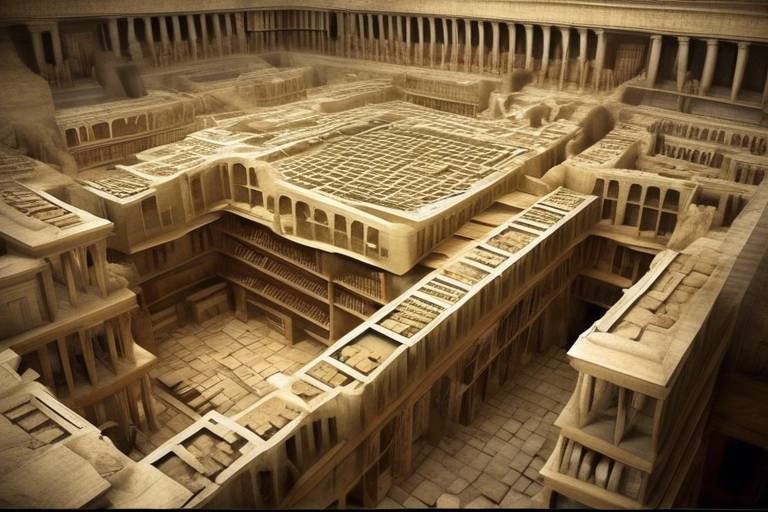The Enigma of the Pyramids - How Were They Built?
Have you ever gazed in awe at the majestic Egyptian pyramids and wondered about the incredible feat of engineering and construction behind these ancient wonders? The enigma of the pyramids continues to captivate the minds of people worldwide, sparking curiosity and debate over the centuries. How were these monumental structures built with such precision and grandeur, standing as enduring testaments to the ingenuity and skill of the ancient Egyptians?
Exploring the mysteries shrouding the construction of the Egyptian pyramids unveils a tapestry of theories, tools, and techniques employed by the builders of antiquity. From the historical context of Egyptian pyramids to the architectural design and layout, each aspect offers a glimpse into the complexity and sophistication of ancient Egyptian civilization.
Delving into the historical context of Egyptian pyramids unravels a rich tapestry of cultural significance and historical evolution. These iconic structures served as tombs for pharaohs, embodying the belief in the afterlife and the divine authority of the rulers. The evolution of pyramid construction techniques across different dynasties reflects the advancement in engineering prowess and architectural innovation.
When examining the architectural design and layout of Egyptian pyramids, one is struck by the meticulous precision and alignment displayed in their construction. From the orientation towards cardinal points to the symbolism embedded in their shapes, each pyramid tells a story of mathematical precision and spiritual symbolism.
The construction methods and techniques employed by ancient Egyptian builders unveil a remarkable blend of innovation and labor organization. Ramps, levers, pulleys, and the strategic coordination of the workforce facilitated the transportation and placement of massive stone blocks, culminating in the creation of these monumental edifices.
Amidst the tools and technology available to pyramid builders, the craftsmanship of skilled artisans and engineers played a pivotal role in shaping these architectural marvels. Copper chisels, wooden mallets, and measurement tools exemplified the ingenuity of ancient Egyptian technology, underscoring the mastery of craftsmanship in pyramid construction.
Dispelling myths and misconceptions surrounding the construction of Egyptian pyramids is essential to unraveling the truth behind these enigmatic structures. From theories of alien intervention to speculations about lost civilizations, separating fact from fiction is crucial in understanding the true legacy of the pyramids.
Recent archaeological discoveries and research findings have shed new light on the construction techniques and organizational structure behind the Egyptian pyramids. These insights offer valuable glimpses into the labor force dynamics, technological innovations, and societal organization that underpinned the construction of these enduring symbols of ancient Egypt.
The legacy and cultural impact of Egyptian pyramids extend far beyond their physical presence, influencing art, architecture, and societal beliefs for millennia. As symbols of ancient Egyptian civilization and engineering prowess, the pyramids stand as timeless monuments to human achievement and architectural excellence.
However, challenges and unanswered questions persist in unraveling the full extent of the mysteries surrounding the construction of Egyptian pyramids. Future investigations and technological advancements hold the promise of unlocking new insights and unveiling the secrets that continue to shroud these enigmatic structures in an aura of fascination and wonder.

Historical Context of Egyptian Pyramids
Exploring the mysteries surrounding the construction of ancient Egyptian pyramids, including theories, tools, and techniques used by the builders to create these monumental structures that continue to fascinate and intrigue people around the world.
Delving into the historical context of Egyptian pyramids takes us back to the ancient civilization that revered these majestic structures. The pyramids were not just massive tombs but also symbols of power and belief systems of the pharaohs. Over different dynasties in ancient Egypt, the purpose and design of pyramids evolved, reflecting changes in religious practices and architectural advancements.
The construction of pyramids was deeply intertwined with the spiritual beliefs of ancient Egyptians, who saw them as gateways to the afterlife. The meticulous planning and execution of pyramid construction were not merely architectural feats but also sacred rituals performed with precision and reverence.
As the dynasties changed, so did the techniques and methods used in building pyramids. From the step pyramid of Djoser to the smooth-sided pyramids of Giza, each structure represented a unique chapter in the history of Egyptian civilization, showcasing the ingenuity and craftsmanship of the builders.
Moreover, the alignment of pyramids with the cardinal points held symbolic significance, connecting the earthly realm with the celestial planes. The layout and orientation of these structures were not random but purposeful, reflecting the cosmological beliefs of the ancient Egyptians.
Through the historical context of Egyptian pyramids, we gain insight into the rich tapestry of beliefs, traditions, and innovations that shaped these architectural wonders, leaving a lasting legacy that continues to captivate the world.

Architectural Design and Layout
When it comes to the architectural design and layout of the Egyptian pyramids, one cannot help but marvel at the precision and grandeur of these ancient structures. The pyramids were not just massive tombs but also architectural wonders that showcased the engineering prowess of the ancient Egyptians. The layout of the pyramids was meticulously planned, with each side aligned perfectly with the cardinal points of the compass. This alignment was not just a coincidence but a deliberate design choice that held symbolic significance for the ancient Egyptians.
The shape of the pyramid itself, with its four triangular sides meeting at a single point, was laden with symbolism. The pyramid was believed to represent the primordial mound from which the ancient Egyptians believed the world was created. This sacred shape was not just a testament to the architectural skills of the builders but also a reflection of the religious beliefs and cosmology of the ancient Egyptian civilization.
Moreover, the architectural design of the pyramids extended beyond just their external appearance. The internal layout of the pyramids was equally intricate, with complex passageways, chambers, and corridors carefully integrated into the structure. The Great Pyramid of Giza, for example, contains a series of chambers and passages, including the King's Chamber and the Queen's Chamber, each with its own unique architectural features.
One of the most fascinating aspects of the architectural design of the pyramids is the precision with which they were constructed. The builders of the pyramids had to ensure that the angles and dimensions of the structure were exact, requiring meticulous planning and execution. The use of advanced mathematical calculations and surveying techniques allowed the ancient Egyptians to achieve such remarkable precision in their architectural endeavors.
Overall, the architectural design and layout of the Egyptian pyramids stand as a testament to the ingenuity and skill of the ancient builders. These monumental structures continue to captivate the imagination of people around the world, inspiring awe and wonder at the remarkable achievements of the ancient Egyptian civilization.

Construction Methods and Techniques
When it comes to the construction of the ancient Egyptian pyramids, the methods and techniques used by the builders have long been a subject of fascination and debate. One of the most prominent theories suggests that ramps were utilized to transport the massive stone blocks to the construction site and elevate them to the desired heights. These ramps, believed to have been constructed using mud bricks and limestone, provided a gradual incline for the workers to move the heavy materials.
Moreover, the use of levers and pulleys played a crucial role in the positioning of the stone blocks, allowing the workers to maneuver the blocks with precision and place them in their designated locations. The coordination and organization of the workforce were essential in ensuring the smooth progress of the construction process, with skilled craftsmen and engineers overseeing the intricate tasks involved in pyramid building.
Additionally, the ancient Egyptian builders employed innovative techniques to quarry and shape the stone blocks used in the construction of the pyramids. Copper chisels and wooden mallets were commonly used to carve the stones with remarkable precision, while measurement tools helped maintain the accuracy of the dimensions required for the construction.
Furthermore, the alignment of the pyramids with the cardinal points demonstrates the advanced knowledge and astronomical understanding possessed by the ancient Egyptians. The precise orientation of the pyramids towards the north, south, east, and west reflects the significance of celestial alignment in the architectural design of these monumental structures.
In conclusion, the construction methods and techniques utilized by the ancient Egyptian builders in creating the iconic pyramids remain a testament to their ingenuity and engineering prowess. The mysteries surrounding the construction process continue to captivate researchers and enthusiasts alike, inspiring ongoing investigations and discoveries that contribute to unraveling the enigma of these ancient wonders.

Tools and Technology of Pyramid Builders
When it comes to the construction of the ancient Egyptian pyramids, one cannot overlook the remarkable tools and technology that were available to the pyramid builders. These skilled craftsmen and engineers utilized a variety of tools to carve, transport, and place the massive stone blocks that make up these monumental structures.
One of the primary tools used by the pyramid builders was the copper chisel, which was essential for shaping the stones with precision. Alongside the chisels, wooden mallets were employed to strike the chisels and drive them into the stone. This combination of tools allowed the builders to meticulously carve the stones into the desired shapes and sizes.
In addition to basic hand tools, the ancient Egyptians also utilized measurement tools to ensure accuracy in their construction. These tools enabled the builders to maintain consistent dimensions and alignments throughout the building process, contributing to the overall structural integrity of the pyramids.
Furthermore, the construction of the pyramids required a significant amount of organization and coordination among the workforce. Skilled laborers, including stonecutters, masons, and laborers, worked together under the direction of experienced engineers to execute the intricate construction plans.
While the tools used by the pyramid builders may seem primitive by today's standards, it is essential to recognize the ingenuity and craftsmanship that went into creating these architectural marvels. The combination of advanced techniques, skilled labor, and precise tools allowed the ancient Egyptians to achieve feats of engineering that continue to astound and inspire us to this day.

Debunking Mysteries and Myths
When it comes to the construction of the Egyptian pyramids, numerous mysteries and myths have captured the imagination of people for centuries. One of the most persistent myths is the idea that these ancient structures were built with the help of extraterrestrial beings or advanced lost civilizations. However, archaeological evidence and research findings have debunked these fantastical theories, pointing instead to the ingenuity and resourcefulness of the ancient Egyptian builders.
Contrary to popular belief, the construction of the pyramids was not accomplished through supernatural means or alien intervention. Instead, it was a testament to the skill and expertise of the ancient Egyptians, who developed sophisticated techniques and tools to undertake such monumental projects. The idea of advanced technology or mystical powers playing a role in pyramid construction has been largely discredited by experts in the field.
One common misconception is the belief that the massive stone blocks used in the construction of the pyramids were transported and placed using unknown methods or technologies. In reality, ancient Egyptian builders utilized simple yet effective tools such as ramps, levers, and pulleys to move the heavy stones into position. The organization of labor and the sheer manpower involved in the construction process were key factors in achieving such remarkable feats of engineering.
Moreover, the notion that the alignment and precision of the pyramids' construction are too perfect to have been achieved by human hands alone has been refuted by detailed studies and measurements. The careful planning and meticulous craftsmanship exhibited in the layout of the pyramids demonstrate the meticulous attention to detail and architectural skill of the ancient builders.
By dispelling these myths and misconceptions surrounding the construction of the Egyptian pyramids, we can appreciate the incredible achievements of the ancient Egyptians and gain a deeper understanding of the cultural and historical significance of these iconic structures.

Recent Discoveries and Research Findings
Recent archaeological discoveries and research findings have provided valuable insights into the construction of Egyptian pyramids, unraveling some of the long-held mysteries surrounding these ancient marvels. One significant discovery was the identification of a large ramp system at the site of Hatnub, which was used to transport the massive limestone blocks used in pyramid construction. This finding shed light on the logistical challenges faced by the builders and the sophisticated engineering solutions they devised.
Moreover, recent studies utilizing advanced imaging techniques have revealed hidden chambers and passageways within the pyramids, offering new avenues for exploration and research. These findings have sparked renewed interest in the internal structures of the pyramids and the possible purposes of these hidden spaces, fueling further investigations and excavations.
Additionally, isotopic analysis of the stone blocks has provided clues about the quarries from which they were sourced, tracing the origins of the materials used in pyramid construction. By matching the chemical composition of the stones with geological samples, researchers have been able to map out the ancient trade routes and quarry locations, enhancing our understanding of the supply chain logistics involved in building the pyramids.
Furthermore, recent research has focused on the labor force involved in pyramid construction, revealing the presence of skilled craftsmen, engineers, and laborers who worked together in a highly organized manner. By studying the burial sites and artifacts associated with the workers, archaeologists have gained insights into the social structure and division of labor within the workforce, painting a more detailed picture of the human aspect behind the monumental construction projects.

Legacy and Cultural Impact
When it comes to the legacy and cultural impact of Egyptian pyramids, one cannot underestimate their profound influence on art, architecture, and society. These majestic structures stand as enduring symbols of ancient Egyptian civilization, showcasing the remarkable engineering prowess and artistic achievements of the time. The pyramids have captured the imagination of people worldwide, serving as iconic representations of the grandeur and mystique of ancient Egypt.
The legacy of the Egyptian pyramids extends beyond their physical presence, permeating various aspects of modern culture. From literature to films, the enigmatic allure of the pyramids continues to inspire creative works and fuel curiosity about the secrets they hold. Their symbolic significance as monuments of power, wealth, and religious beliefs has transcended time, leaving a lasting imprint on the collective consciousness of humanity.
Moreover, the cultural impact of the pyramids goes beyond mere admiration for their architectural marvel. These structures serve as tangible links to the past, offering insights into the beliefs, values, and technological achievements of the ancient Egyptians. The meticulous planning and construction of the pyramids reflect the organizational skills and ingenuity of a civilization that thrived thousands of years ago, leaving a legacy that continues to fascinate scholars and enthusiasts alike.
Furthermore, the pyramids have become emblematic of Egypt itself, symbolizing the country's rich history and cultural heritage. Tourists from around the world flock to Egypt to marvel at these wonders of the ancient world, contributing to the country's tourism industry and economy. The pyramids serve as ambassadors of Egypt's past, drawing visitors to explore the mysteries and wonders of this ancient land.
In conclusion, the legacy and cultural impact of Egyptian pyramids are profound and far-reaching, transcending geographical boundaries and time periods. These architectural marvels stand as testaments to human ingenuity and ambition, inspiring awe and wonder in all who behold them. The pyramids continue to be symbols of Egypt's enduring legacy and serve as reminders of the remarkable achievements of one of the world's greatest civilizations.

Challenges and Future Investigations
As we delve into the mysteries of the ancient Egyptian pyramids, we are faced with numerous challenges and unanswered questions that continue to baffle researchers and historians alike. One of the primary challenges in understanding the construction of these monumental structures lies in deciphering the exact methods and techniques used by the ancient builders. Despite various theories and hypotheses, the precise process of how the massive stone blocks were transported and placed with such precision remains a subject of debate and intrigue.
Furthermore, the sheer scale and complexity of pyramid construction present significant obstacles in unraveling the mysteries surrounding their creation. The logistics involved in organizing the workforce, coordinating the construction efforts, and ensuring the structural integrity of the pyramids pose formidable challenges to modern researchers attempting to reconstruct the building process.
Future investigations into the construction of Egyptian pyramids hold the promise of uncovering new insights and revelations that could reshape our understanding of these ancient marvels. With advances in archaeological techniques, such as ground-penetrating radar and 3D modeling, researchers are poised to gain a deeper understanding of the internal structure and construction methods employed in building the pyramids.
Moreover, interdisciplinary collaborations between archaeologists, engineers, and historians offer a holistic approach to studying the pyramids, combining expertise from various fields to tackle the complex challenges posed by these enigmatic structures. By integrating cutting-edge technologies and innovative research methodologies, the future holds the potential for groundbreaking discoveries that could shed light on the enduring mysteries of the Egyptian pyramids.
Frequently Asked Questions
- How were the Egyptian pyramids built?
The construction of the Egyptian pyramids remains a fascinating mystery. While there are various theories, the most widely accepted method involves the use of ramps, levers, and pulleys to transport and place massive stone blocks into position.
- Were the pyramids built by aliens?
Contrary to popular myths and misconceptions, there is no credible evidence to support the claim that the Egyptian pyramids were built by aliens. The construction of the pyramids was a remarkable feat of human engineering and ingenuity.
- What tools did the ancient Egyptians use to build the pyramids?
Ancient Egyptian pyramid builders used tools such as copper chisels, wooden mallets, and measurement tools to cut and shape the stone blocks. Skilled craftsmen and engineers played a crucial role in the construction process.
- Why are the pyramids aligned with the cardinal points?
The alignment of the pyramids with the cardinal points (north, south, east, west) is believed to have had symbolic and religious significance for the ancient Egyptians. It may have been related to their beliefs about the afterlife and the journey of the pharaoh's soul.
- What is the legacy of the Egyptian pyramids?
The Egyptian pyramids have left a lasting legacy on art, architecture, and culture. They serve as iconic symbols of ancient Egyptian civilization and engineering prowess, continuing to inspire awe and admiration around the world.



















